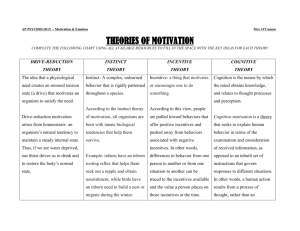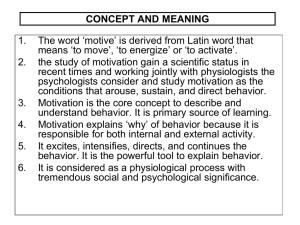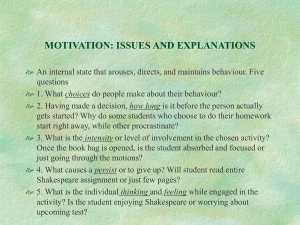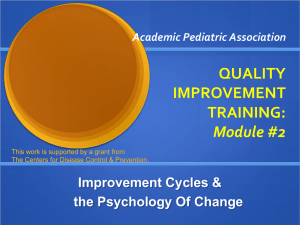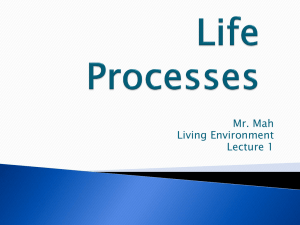File
advertisement
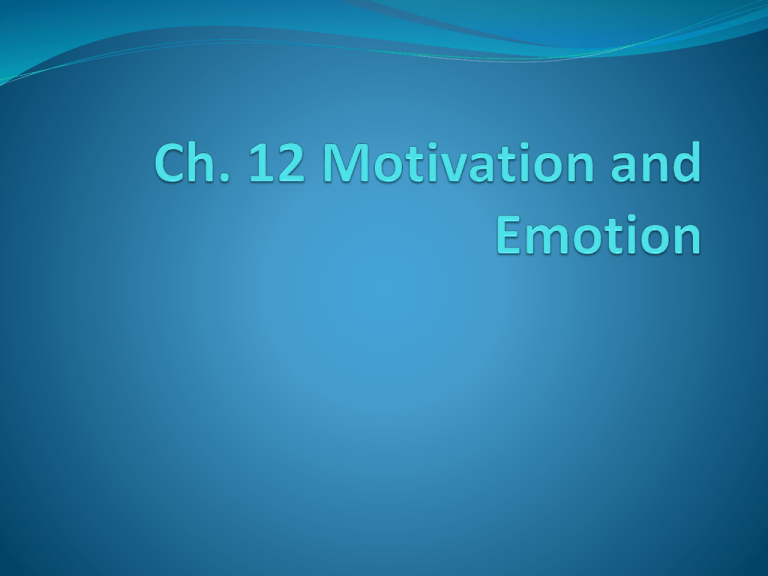
Motivation- part of the underlying whys of behavior. Psychologists explain motivation and why we experience it in different ways through instinct, drivereduction, incentive and cognitive theories of motivation Project: Quick Lab on page 316 Psychological theories of motivation http://youtu.be/OO_jxWJlKgw Daniel Pink- the Science of Motivation http://www.ted.com/talks/dan_pink_on_motivation.h tml Theories of Emotion http://youtu.be/_Al3wGg2hp8 Instinct Theory In the early 1900s a psychologist proposed that humans were motivated by a variety of instincts. Instincts are natural or inherited tendencies of an organism to make a specific response to certain environmental stimuli without involving reason. Instincts occur in almost the same way among all members of species William James- proposed that humans have instincts such as cleanliness, curiosity, parental love, sociability, and sympathy Instinct Theory Psychologists eventually realized a flaw in instinct theory- instincts do not explain behavior; they simply label behavior Drive-Reduction Theory When we are motivated, it moves us to action The thing that motivates us starts with a need that leads to a drive A need results from a lack of something desirable or useful We need oxygen and food to survive (physiological needs)and self-esteem or social approval (psychological needs). A need produces a drive, which is an internal condition that can change over time and orients an individual toward a specific goal or goals. Drive-Reduction Theory According to Clark Hull (1943), when an organism is deprived of something it needs or wants (such as food or water), it becomes tense and agitated. To relieve this tension, it engages in more or less random activity. Thus biological needs drive an organism to act, and the organism strives to maintain homeostasis (tendency of the body to return to or maintain a balanced state. If a behavior reduces the drive, the organism will begin to acquire a habit. D-R Theory When the drive is again felt, the organism will first try the same response. Habits channel drives in certain directions. D-R Theory states that physiological needs drive an organism to act in either random or habitual ways. This drive continues until the organism’s needs are satisfied and it returns to a preset optimal state. D-R Theory Hull suggested that all human motives- from the desire to acquire property to striving for excellence and seeking affection or amusement are extensions of basic biological needs. Ex. People develop the need for social approval because as infants they were fed and cared for by a smiling mother or father. Gradually, through conditioning and generalization, the need for approval becomes important in itself. Thus approval becomes a learned drive. D-R Theory Subsequent experiments have shown that Hull may have overlooked some of the more important factors in human motivation. Sometimes we engage in activities that increase the tension we experience- watching a scary movie, riding a roller coaster- increases anxiety and disrupts your homeostasis There are many types of behavior that cannot be explained through deprivation. Incentive Theory Drive- Reduction theory of motivation emphasizes the internal states of the organism Incentive theory stresses the role of the environment in motivating behavior A drive is something inside of us that causes us to actour actions are directed toward a goal, or incentive An incentive is the object we seek or the result we are trying to achieve through our motivated behavior. Incentives are also known as reinforcers, goals, and rewards. Incentive Theory Drives push us to reduce needs Incentives pull us to obtain them. Hunger may cause us to walk to the cafeteria, but the incentive for our action is the sandwich we intend to eat. People are generally motivated to obtain positive incentives and to avoid negative incentives. What could be a positive incentive? Praise or recognition. How are incentives different from drives? Drives are internal while incentives are external. Cognitive Theory Cognitive psychologists seek to explain motivation by looking at forces inside and outside of us that energize us to move. We act through extrinsic motivation- engage in activities to reduce biological needs or obtain incentives or external rewards. Intrinsic motivation refers to engaging in activities because those activities are personally rewarding or because engaging in them fulfills our beliefs or expectations. Cognitive Theory For example, if you spend hours and hours playing basketball because you wish to excel at the sport, you are following intrinsic motivation. If you spend hours playing basketball because your parents want you to excel at the sport, you are following extrinsic motivation. If you play just for the fun of it, you are following intrinsic motivation. Cognitive Theory Both motivations- You may go out to dinner with your friends because you need to satisfy your hunger (extrinsic motivation)and wish to socialize with your friends (intrinsic motivation). If you are motivated by both intrinsic and extrinsic motivations, do you perform more effectively or persistently at a task? Cognitive Theory Overjustification effect: When people are give more extrinsic motivation than necessary to perform a task, their intrinsic motivation declines. Say you enjoy reading books- according to the overjustification effect, if someone started paying you to read books, you would enjoy reading books less. Why am I doing this? If you get paid less, you might start reading less. If you are no longer paid to read books, you might lose all interest in the task. Social Motives Measuring the need for achievement: Thematic Apperception Test Fear of failure Fear of success Maslow’s Hierarchy of Needs Maslow’s Hierarchy of Needs Fundamental needs- hunger Psychological needs- need to belong, need to love, acquire esteem through competence and achievement Self-actualization needs Theories of Emotion – chart p. 335 http://youtu.be/_Al3wGg2hp8 TAT Experiment: http://www.utpsyc.org/TATintro/ Maslow’s Hierarchy of Needs http://youtu.be/yM8SwZkvCIY That’s it.
